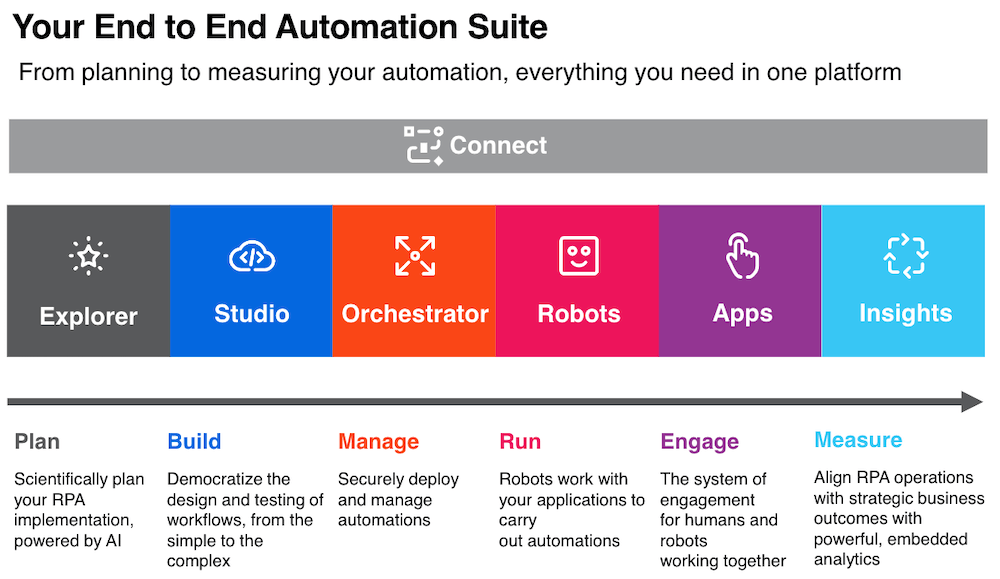Why Chief Information Officers Need To Take Robotic Process Automation Seriously

My name is Justin Greenberger, and I have the honor of operating our customer success program here at UiPath. My passion is evolving technology, and most of that comes from my background.
Before UiPath, I had the opportunity to serve as chief information officer (CIO) at General Electric (GE) Digital. I reported to the CIO of GE and went through all the typical CIO conversations: application simplification, big enterprise resource planning (ERP) deployments, too many reporting tools, master data management, shadow IT, and of course, I got a call when the CEO’s screen share was broken.
Fast forward a couple of years and this year, at FORWARD III in Las Vegas, I spoke with a dozen CIOs from Fortune 500 companies to learn more about how they are looking at robotic process automation (RPA) and the role it plays in their organizations.
As a former CIO, some of the themes that came up (such as shadow IT and classic ROI models) were all too familiar. After all, the job of a CIO is tough and there’s monumental pressure every quarter to deliver stronger results with less budget. But recently there has been a growing trend for CIOs to step away from some of the classic IT mindsets and approach digital transformation with a fresh set of tools and mindsets.
The takeaways from these conversations got me thinking and there are a few key areas that apply to the work we are doing across UiPath.
RPA as a Band-Aid
As a part of my job at UiPath, I get to talk to a lot of customers globally. Many of the questions orientate around the topic of RPA as a Band-Aid. I don’t disagree with this at all, and actually, think it could be the best Band-Aid ever created. There are two ways I think about this conversation:
1. ROI still matters
ERP simplification remains a common topic in most companies. Typically, organizations have overcomplicated their system landscape or over customized their current ERP. The trend in the industry seems to be moving to a simpler, less complicated ERP. However, that could be a global deployment to eliminate systems that might cost the company barely anything.
My favorite example is the ERP I had operating in India for US$20,000 annually. Moving that ERP to a strategic ERP would have cost at least US$500,000. Logic tells you to move it, but we took a different tactic. We used RPA to address data concerns, as well as standardize accounts payable across the business unit. Our approach might have been a Band-Aid but it made sense and added value.
2. Systems are persona based
Your strategic systems will always have intended uses, and I think most software vendors do a good job articulating who the audience is. However, when you deploy a customer relationship management (CRM) tool or an ERP, there are always going to be use cases for what we call “attended automation.”
In attended automation, software robots work alongside humans to share the workload in realtime. Those use cases might be a feature you can’t deploy due to time considerations, or a feature the system hasn’t deployed yet. All of this is possible with automation as a layer above the tool that you’re deploying. This might be a temporary fix or a permanent solution as people see productivity from the attended RPA robot.
RPA as a tool to reduce the noise
As a CIO, I wanted to spend more time on user experience but there was always a critical feature to close the books or meet compliance that was prioritized. RPA allows those features that might have been “nice to have” come back onto the deployment schedule.
I’ve seen this in action while working with UiPath customers. For instance, we have a Fortune 50 retail customer that had a large ERP deployment scheduled. Their ERP team (like every other ERP team) was stressed to get phase one deployed, and a lot of the user experience features fell off the roadmap due to time constraints. The finance team stepped in and developed their own software robots to make up for features that might not have gotten implemented. I was blown away at their ability to work together, and that IT didn't feel like they had to do everything. The ERP went live, and the users were extremely happy with the implementation and robots. And just like that, the team delivered a happy ERP deployment.
RPA as a strategic project enabler
With our recent announcements around process discovery and analytics, we’re continuing to put together the picture of UiPath as the platform that connects your entire automation lifecycle (critical for accomplishing digital transformation).

Digital transformation is a really good (and overused) marketing term, but there’s a very tactical way to think through this. Most, if not all customers I talk to, have a digital transformation story. They’re rethinking how to do banking, customer operations, finance transformation, and more. These transformation stories usually entail staffing changes, talent shifts, culture shifts, and commercial model changes - all of which can require a heavy investment from the executive team.
Here’s what Prakash Kota, CIO at Autodesk, shared about the role of CIOs and digital transformation in the panel “How Automation Empowers the Chief Information Officer” at FORWARD III last month:

When you think about RPA as a strategic enabler to these digital transformation stories, it becomes a differentiated tool. If we use commercial operations as a transformation opportunity, RPA could be the underlying platform for that whole initiative. There can be automation around contract language, onboarding, know your customer (KYC), and master data management.
Automation enables digital transformation to happen in a very tactical way
Using RPA to make artificial intelligence (AI) real
When I was CIO, I was very much one of those people that didn’t buy that AI was a real ability we had available. I thought AI enabled some pretty dashboards but fell short when we tried to use it in a way that could change the business.
I fundamentally believe that AI initiatives that are ongoing will have trouble enacting action without custom scripting, a service-orientated architecture, or mass digitization at the middleware layer.
RPA as a base for all AI makes it easy to incorporate AI-driven models
I just came back from a presentation to a group of CTOs in Washington D.C., and amongst a highly technical audience, we presented the methodology. The use case that resonated was an example of invoices on hold. In a traditional machine learning (ML) model, trained algorithms would learn how to classify invoices on hold. Whether the hold is the result of an address issue, customer dispute, or a multitude of other problems, the algorithm could easily classify and learn the failure modes. To expand classification into action requires some sort of automation platform to take action. This is where I believe the complement will always exist between RPA and AI.
I think in IT we sometimes get caught up in tool simplification, governance, and big initiatives that take time and sometimes lose value. As RPA has matured, it has provided a new lens in terms of digital transformation and become an even more valuable tool for CIOs.
Want to know more about how RPA drives value for your organization?
Download your complimentary copy of the IT Central Station: RPA and the Fulfillment of the CIO’s Mandate report.
CIOs can now use RPA as a tool to lower the total cost of ownership, drive revenue in areas traditionally lost, and have higher user experience on legacy systems. All those goals were not achievable in a different world of automation, but are now all possible with RPA. This is a topic that is at the heart of what we do at UiPath and one I would love to chat more about – reach out to me on LinkedIn and let’s continue the conversation.

VP, Customer Success & Sales Engineering, UiPath
Get articles from automation experts in your inbox
SubscribeGet articles from automation experts in your inbox
Sign up today and we'll email you the newest articles every week.
Thank you for subscribing!
Thank you for subscribing! Each week, we'll send the best automation blog posts straight to your inbox.



